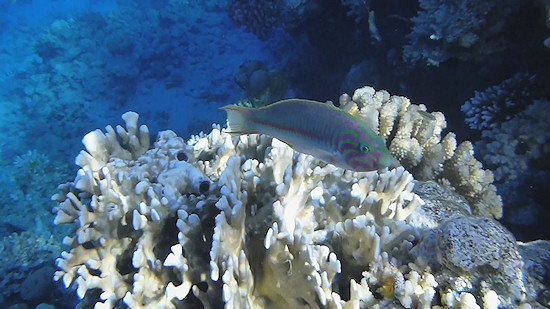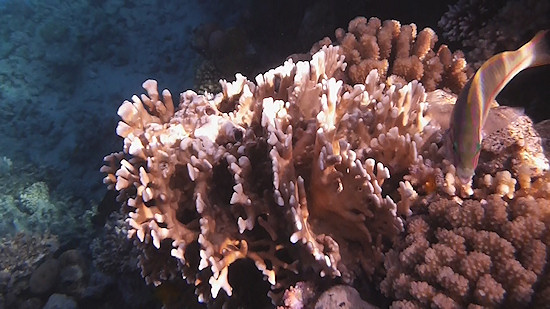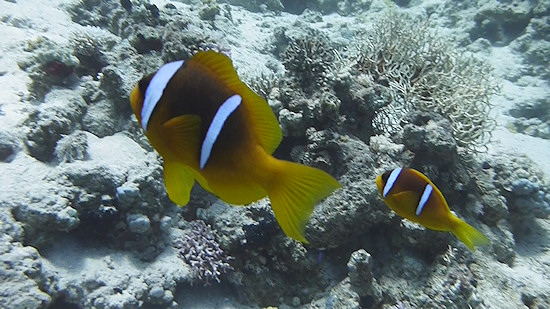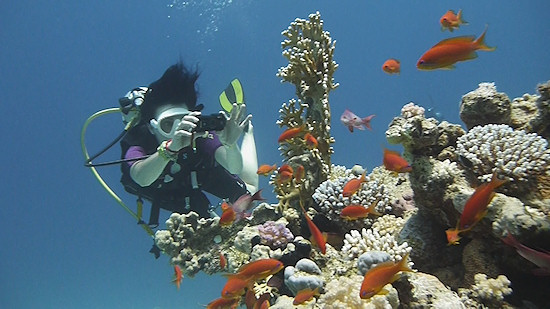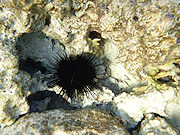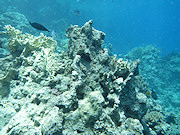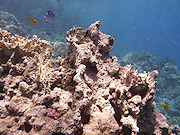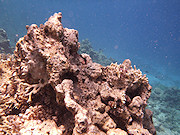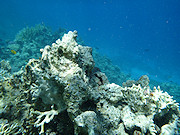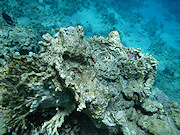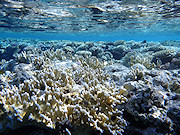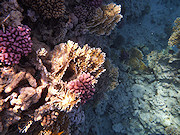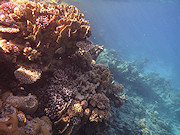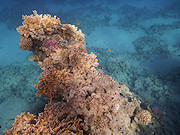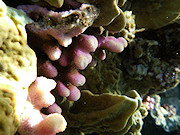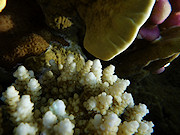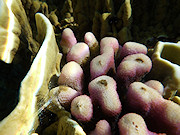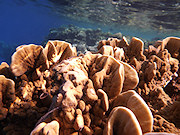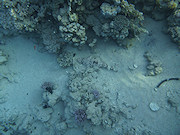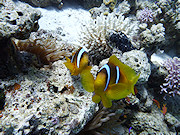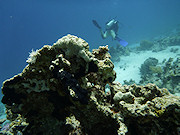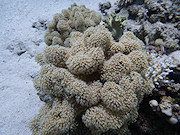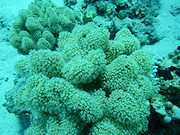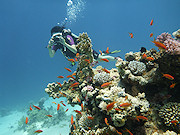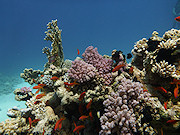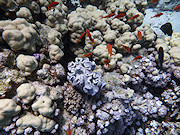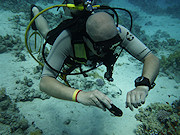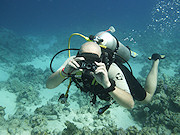Underwater cameras test 2011
4. Panasonic Lumix DMC-FT3
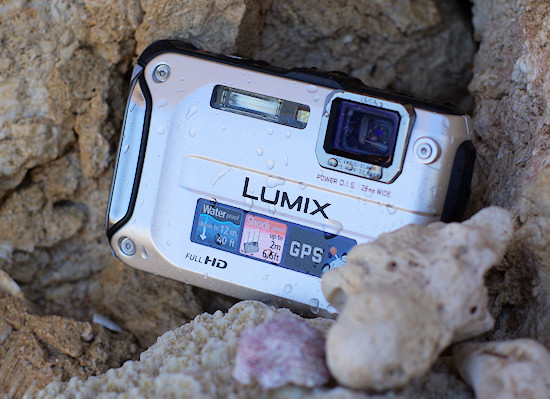 |
The Panasonic Lumix FT3 is, after the FT1, the FT2 and the FT10 models, already the fourth underwater device, launched by this Japanese producer. It is an immediate successor of the FT2 and this chart presents the comparison between its technical specifications and those of older models.
The first thing that sticks out is the fact that a sensor with lower resolution, amounting now to 12 Mpix, was used here. The sensor is supported by the new image processor, Venus Engine FHD, which allows you to record videos in the Full HD 1920×1080 50i pixels resolution, utilizing the AVCHD coding. The burst mode also was improved, now allowing you to take photos as fast as 3.7 fps and the new AF module uses 23 focusing points.
Most of other parameters are known from the FT1 and FT2 models. As a result in the new camera you find a 2.7-inch LCD screen with the resolution of 230K points, the same LEICA DC VARIO-ELMAR lens, consisting of 10 elements set in 8 groups (including 5 aspherical elements, 6 aspherical surfaces and 1 ED element). Its equivalent of focal lengths range is 28-128 mm and the aperture ranges from f/3.3 to f/5.9.
Please Support UsIf you enjoy our reviews and articles, and you want us to continue our work please, support our website by donating through PayPal. The funds are going to be used for paying our editorial team, renting servers, and equipping our testing studio; only that way we will be able to continue providing you interesting content for free. |
- - - - - - - - - - - - - - - - - - - - - - - - - - - - - - - - - - - - - - - - - - - - - - - -
The fact that the Lumix FT3 features a GPS module, a compass, a manometer and an altimeter is certainly worth our attention. The casing was reinforced so now you can dive with this camera to a depth of 12 m and it can survive the fall from 2 meters. The device is also dustproof, in accordance with the IPX6 norm. Such changes made the camera weight 10 grams more than the older model – now its weight with a memory card and a battery amounts to 197 grams. The dimensions of the camera (103.5×64.0×26.5 mm ) increased as well, being now about 15% bigger than in the case of the FT2.
Design and build quality
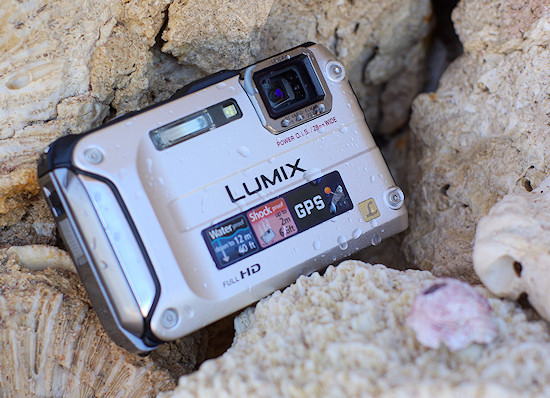 |
The solidity of the Panasonic’s FT3 casing is beyond reproach. The camera is very sturdy; nothing creaks and there are no slacks as all elements fit each other precisely. The front and back panels are made of aluminum. Luckily it is not brushed, as it was the case of previous models as it influenced the cleaning but we will tell you more about it in the following subsections.
A window protecting the LCD screen is quite stiff but it remains a far cry from that used in the Olympus TG-810. As a result at 10 m it is pressed to the screen surface quite strongly and in future it might lead to a screen damage.
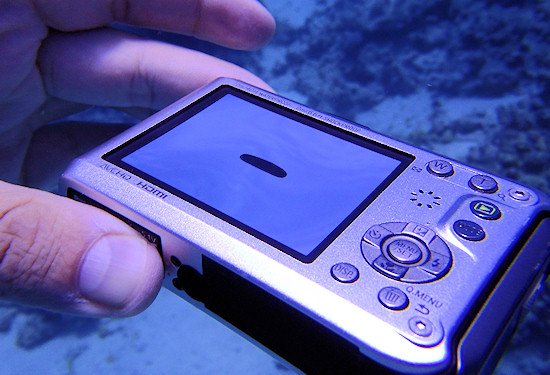 At the depth of 10 m the pressure of water column is twice as big as that of air on the surface. It presses the LCD screen window and, as a result, it bends inside. |
One of the side panels is in fact a cover protecting an USB and a mini HDMI ports as well as a battery and a memory card slot. Its usage is problem-free – it closes and opens comfortably and it is equipped with a blockade slider which prevents an accidental opening.
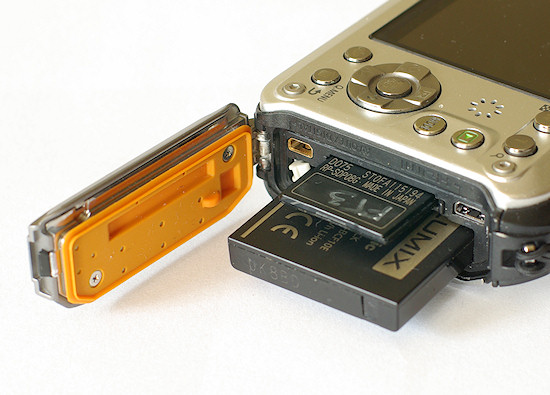 |
The front panel, compared to the older model, didn’t change much, because the only one significant difference which can be noticed is a profiled grip which is supposed to make the handling more comfortable. One glance at the back and upper panel is enough to see a lot of changes, though. First of all the new model doesn’t feature a selection wheel. In previous tests we praised such a solution in underwater cameras because it made switching between available underwater modes definitely easier (especially in Lumix cameras). Unfortunately in the FT3 model we get a MODE button instead which displays a menu with available modes. Right above that button you can find a playback key and W and T buttons, responsible for focal length change. Other manipulators on the back panel are already known from the previous model: among them we can find a MENU/SET button, surrounded by directional controllers which give us a quick access to exposure correction settings, a macro mode, a delayed-action release and a flash. Below the four-way controller there is a DISP. button, responsible for the change of info you see on the screen and a Q.MENU button, which starts the quick menu, featured by almost all Panasonic cameras.
 |
More perceptive people certainly will notice that on the back panel there is no video recording button, known from the FT2. According to the current trend, followed by the Lumix constructors, it was moved to the upper panel where it was placed near the shutter release and the power button.
Use, cleaning, wear and tear
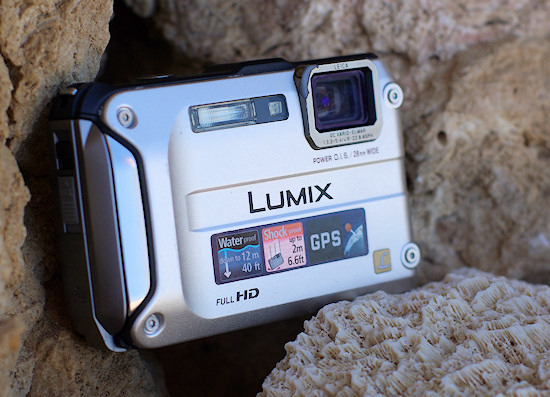 |
The FT3 camera, which was sent to our editorial office, had been already tested several times. You could notice some small traces of wear and tear, unavoidable during a normal everyday usage. Unfortunately one thing made us worry. The chromium-plated element around the lens had already peeled off a bit. During our test the damage became even more pronounced – it doesn’t place that element in a favourable light.
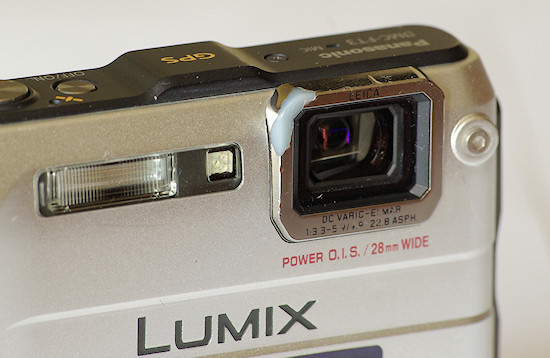 |
Apart from that one flaw we didn’t notice any serious damages on the tested Lumix – overall no deeper scratches and those on the LCD screen were very superficial and not numerous.
The cleaning of the FT3 is not the easiest thing because there are plenty of nooks and crannies where dirt and salt can gather. In order to make it a bit less onerous the producer included a very useful little brush which removes all dirt from the casing and also from a sealing of the cover – if some dirt is deposited there the camera might lose its waterproof quality. As always such an addition is a plus; we only hope that it won’t disappear in the future as it was the case of another very useful accessory, added to the box with the FT2. We think here about a silicon jacket which protected the camera very well in difficult conditions and made it easier to hold even in wet hands at the same time. Unfortunately in the box with the FT3 you couldn’t find this accessory any more.
Additional functions
The list of additional functions, offered by this camera, is really impressive. In the new Panasonic you can find a manometer, a depth gauge, an altimeter, a compass, a GPS module and also the panoramic photo mode and 3D. You must admit it is a lot and it made us even more curious how the individual functions worked.
First we checked the GPS module. When we started it in Egypt after several minutes we saw a communicate on the screen that informed us about the lack of access to the GPS function in that region. Despite several other attempts we couldn’t manage to receive a signal from any satellite.
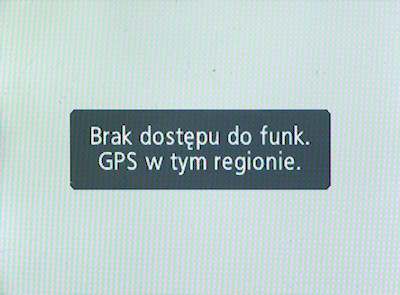 |
A bit disappointed, we checked it once again in Poland – once again without any positive result. The instruction manual of the camera does mention such a possibility but only in China or along its borders with neighboring countries. It seems either I was very distracted during my geography lessons and China is situated closer to Poland and Egypt than I though or simply the GPS doesn’t work properly in the tested camera. It’s worth adding, though, that nothing indicated a possible GPS damage because the diode, informing about the positioning, was on at the right moment.
Testing other additional functions made us equally disappointed. For example the depth gauge. As you remember from the Olympus TG-810 test it is a very functional tool. In the Panasonic, unfortunately completely useless. All because of its lack of accuracy. The indications of the depth gauge are limited to a yellow stripe which moves through a scale between 0 m and 10m. However this stripe’s length corresponds to about 3 m on the aforementioned scale and any movement can be registered only if you descend to a depth of about 5 m. Still its value doesn’t change much and, as a result, it might indicate a depth ranging from about 2 m to 8 m.
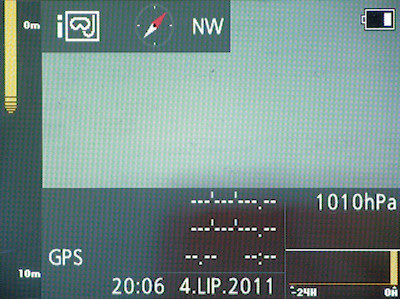 |
Not very accurate, you must admit. Especially when it is available only in the “beach and snorkeling” mode and doesn’t work in the “underwater photos” mode; perhaps the producer anticipated the latter mode to be used only with an underwater casing and in that casing, as you know, the pressure doesn’t change with the increase of depth. What’s more the indications of the depth gauge and manometer can be followed only on a specially dedicated screen which is shown above. You can’t display the actual depth on the screen used for photo taking, where only the exposure parameters are shown.
Really very disappointed, we decided to check the work of the altimeter. We happened to be on a balcony of the second floor so around 10 m above the sea level and after the calibration the altimeter indicated the altitude between 8 and 15 meters. Once again the accuracy of measurements leaves a lot to be desired. Fortunately at least the compass was more or less precise.
At the end let’s mention the panoramic photo function. Unfortunately the camera doesn’t put the photos together automatically but only makes it easer to take such pictures which would be later assembled easily into a panorama using a computer.
As you see if something looks great on the paper it doesn’t necessarily works well in practice – the additional functions, implemented in the FT3, in most of cases were a one big misunderstanding.
Underwater usage
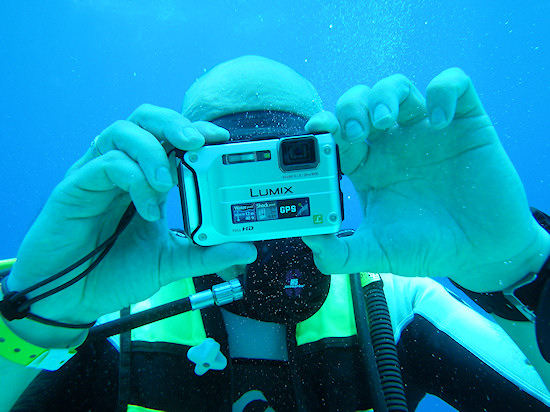 |
As we already mentioned, in the Panasonic FT3 a selection wheel was replaced by a MODE button – when you press it you can see the recording mode menu displayed and then, using the directional keys you can select the appropriate photographic mode. The choice can be made between a fully automatic iA mode, “Normal photo” mode (the equivalent of the P mode), “Snow”, “Beach and snorkeling”, “Underwater photos”, SCN” (this option hides a selection menu of over 20 thematic modes) and a 3D photo mode.
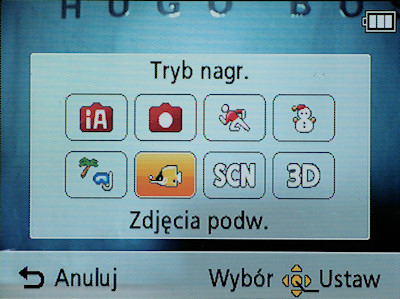 |
You can forget about a comfortable switch between particular modes, which was available in the FT1 and the FT2 from the level of the selection wheel. The fact that the producer changed the name of some modes came to our attention – the “Beach and surfing” mode now is called “Beach and snorkeling”. It is certainly a good move; we’ve been pointing out for two years now that the expression “Beach and surfing” was rather confusing and didn’t fit a mode which was supposed to be perfect for snorkeling photos, taken close to the surface. Despite that positive accent the producer traditionally didn’t manage to avoid a little slip-up (vide the FT2 test) when it comes to messages displayed during the selection of underwater modes. The message concerning the “Beach and snorkeling” mode says that you can take pictures on a beach and under water to a depth of 12 m and the message displayed after the selection of “Underwater photos” mode says that it is the best mode to the depth of 3 m and suggest that above 12 m you should use an appropriate casing. Once again we deal here with a lot of confusion as the user gets contradictory information; no matter whether you want to swim with the FT3 close the surface or dive deeper you don’t get a clear answer what mode would be the best.
The mere switching between the modes is no longer as comfortable as in the case of the older model. There is no mode selection wheel here so we are forced to display the photographic mode menu, pressing the MODE button, and then use the directional keys to chose an appropriate mode. Fortunately starting the video recording is problem-free – it’s enough you press a dedicated button and the recording starts soon afterwards and is fully automatic. In order to finish your recording it’s enough you press the same button again and the camera, saving the data very swiftly, returns to the photographic mode. We don’t have any reservations about the autofocus speed either because its work is sensational. Also its accuracy is on the highest level - even when the sea was rough and we wanted to shoot in the macro mode we didn’t experience any focusing problems.
The next not exactly positive change, which didn’t do the camera any good, was the substituting of the zoom rocker switch with W and T buttons, positioned on the back panel. The rocker switch was definitely easier to operate, especially during underwater photos, where you hold the camera in two hands as it is shown in the picture above. Your thumb is then on the lower panel of the camera and you don’t need to move it in order to change the focal length because it can be done with your index finger. Dealing with these buttons we must make some effort but instead we get an excellent access to the aforementioned video recording button, right next to the shutter release. You get nothing for nothing.
We can’t express any reservations concerning the quality of images, displayed on the LDC screen used in the tested Panasonic. Even against bright sunlight everything is clear so during snorkeling you won’t have any problems with cropping. Although in this category the standard was raised a bit higher by the Olympus TG-810 still the level presented by the FT3 is very satisfactory.
Traditionally the producer didn’t forget about a wrist strap with a tightening clasp, so praised by us during the FT1 and the FT2 tests. Because of this simple solution you don’t have to worry that the camera will slide off your hand during swimming and will sink to the bottom of the sea. Small detail but nice – especially those testing divers who often have to swim with several cameras hanging over their hand will appreciate it.
Now a word or two about what happens when, after resurfacing, we want to take a photo on dry land quickly and the camera is still in underwater mode. It turns out there is no problem whatsoever – the colouring of such a photo is quite natural and you can see in an sample shot below.
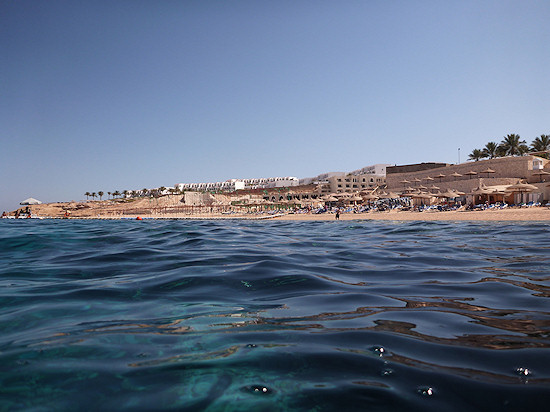 Dry land photo taken in the underwater mode |
As we already mentioned the colouring it’s worth adding that, like the previous models, the FT3 in underwater mode allows you to fine-tune the white balance on a 21-degree scale. Earlier you had had a quick access to this option after pressing the upper directional key three times. We don’t know why but in the tested model it was made more difficult – to reach that option we must display the quick menu, chose the AWB position, and press the DISP button. It is really difficult to say why the producer decided to make the access to such a useful function so unpleasant. What’s even worse, during photographing you can’t find any info concerning the fine-tuning of the white balance displayed on the screen. The result? After earlier tests of this function in the “Beach and snorkeling” mode we left the camera with the blue colour saturation set on a maximum level and simply forgot about it. All pictures taken during the next diving session had to be deleted.
Underwater photos and videos quality
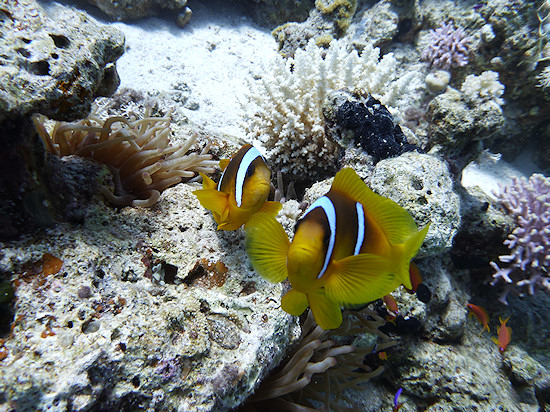 |
When it comes to the colouring of underwater photos by and large nothing has changed since the FT1 model. The producer still offers two underwater modes : the first one is called “Beach and snorkeling” (previously “Beach and surfing”) and the second - “Underwater photos”. In the case of the first one, although we already know it is designed for taking photos just under surface, the results don’t bowl us over when it comes to the colouring of images. You can notice a significant blue dominant which makes the reef not as colourful as in reality. Perhaps two years ago such a level was quite acceptable, but, as the rivals have made a very dynamic progress, the FT3 now is simply lagging behind.
The second mode traditionally takes into consideration the absorption of colours at greater depths and removes the blue dominant from photos. It looks as if we drained the whole water out of the sea. You should notice that the second mode would be useful also during surface diving when you want to photograph objects situated, say, at 3 meters because you register the sunlight reflected from that object which should go 6 m in the water (3 meters to the object and 3 next meters after the reflection toward the surface and the photographer). Otherwise the image is as devoid of colours as if you took a photo of an object from the distance of 1 meter when you are at 5 meters below.
You must remember that removing blue dominant from a photo is often performed by saturating red and orange hues - the colours which are first absorbed by water particles. If an object not deeply submerged and positioned close by is included in your frame, you should take into account the fact that it might be rendered as unnaturally purple.
In order not to sound groundless we present several examples of underwater scenes, photographed using the thematic modes described above. We hope it will help to understand in which situations a particular mode should be used.
| „Beach and snorkeling” mode | „Underwater photos” mode |
|
|
|
|
|
|
|
|
|
|
|
|
|
|
|
Traditionally when there are problems with the automatic white balance in underwater modes we can always get some support in the form of the aforementioned possibility of manual WB regulation – you can choose the right colouring through 21 stops starting from a strong blue dominant and ending with red. Below you can see photos illustrating the full range of smooth white balance regulation.
| The range of white balans regulation in „Beach and snorkeling” mode |
|
|
|
|
|
|
| The range of white balans regulation in „Underwater photo” mode |
|
|
|
|
|
|
Also traditionally we should praise the „Underwater photos” mode which performs very well at greater depths. It allows you to bring out the real colours of objects which are situated at 10 meters under the water surface. Rival cameras in such situations give up, presenting photos in just different shades of blue. The photos taken with the Panasonic look as if you had some additional underwater lighting. It’s enough to consult the photo of clown fish, taken at 8 meters, to know what we mean. If you add to it simply sensational detail rendering, an area the Lumix photos stick out in a positive way, you will get a perfect camera for shallow recreational diving. We must admit that using a sensor with lower resolution did the camera a lot of good because the photos taken with the FT3 are much richer in detail than these, taken with its older, 14-Mpix predecessor.
In green waters with poor visibility the photos noticeably lose a lot of details. As there is not enough light you experience some autofocus problems as well and the camera starts using higher exposure values so stronger anti-fuzz algorithms are employed.
The colouring of images, taken in a lake at 6 meters in the “Underwater photo” mode, is perfect and reflects what you can really see. The “Beach and snorkeling” mode photos feature already strong green dominant but you can always prevent it by fine-tuning the white balance.
Photo taken in a lake at 6 m with the visibility of 2-3 m. „Underwater photo” mode was used. Click to enlarge. |
Photo taken in a lake at 6 m with the visibility of 2-3 m. „Beach and snorkeling” mode was used. Click to enlarge. |
Photo taken in a lake at 6 m with the visibility of 2-3 m. „Beach and snorkeling” mode was used with a higher saturation level of blue colour. Click to enlarge. |
Photo taken in a lake at 6 m with the visibility of 2-3 m. “Beach and snorkeling” mode was used with a higher saturation level of red colour. Click to enlarge. |
You can say practically the same things about the quality of underwater videos as about the quality of photos. They are characterized by a perfect detail rendering, there is not a trace of lossy compression and because of the 50 fps recording the image is smooth and fluid. Autofocus manages very well – even when the sea is rough it can adapt to the ever-changing distance to the photographed object although sometimes it does experience some problems while following moving objects e.g. fish.
When it comes to the colouring the movies are similar to photos. In the “Beach and snorkeling” mode the reef is quite pale, lacking some vividness. The “Underwater photos” mode often introduces purple cast when you swim near the surface; only when you descend a few meters deeper it spreads its wings showing beautiful images in real-life colours, free of blue dominant.
Summary
As always we start by presenting the pros and cons lists:
-
Pros:
- very solid workmanship,
- waterproof up to a depth of 12 m,
- fast work of the camera,
- very quick and precise autofocus,
- the wrist strap with a tightening clasp,
- a brush included in the accessory kit, which makes cleaning easier,
- the right weight of the camera which makes it perform well under water,
- user-friendly Quick Menu button,
- two functional underwater photo modes,
- very good detail rendering in underwater photos,
- sensational colouring of photos taken at great depths,
- right colouring of photos taken on dry land in underwater mode,
- satisfactory colouring of movies recorded on dry land in underwater modes,
- possibility of fine-tuning the white balance in underwater modes,
- splendid colouring of photos taken at great depths in the mode “Underwater photos”,
- splendid colouring of videos recorded at great depths in the mode “Underwater photos”,
- very good colouring of photos taken in a lake in the “Underwater photos” mode,
- sensational detail rendering in movies.
- not very durable chromium element around the lens,
- photos prone to loss of contrast,
- weak colouring of photos taken in the “Beach and snorkeling” mode,
- weak colouring of movies in the “Beach and snorkeling” mode,
- slow change of focal length in the video mode,
- white balance fine-tuning option hidden deep in the menu,
- lack of info about white balance settings on the screen,
- confusing descriptions of underwater modes.
Cons:
Sample underwater videos
Sample underwater shots




